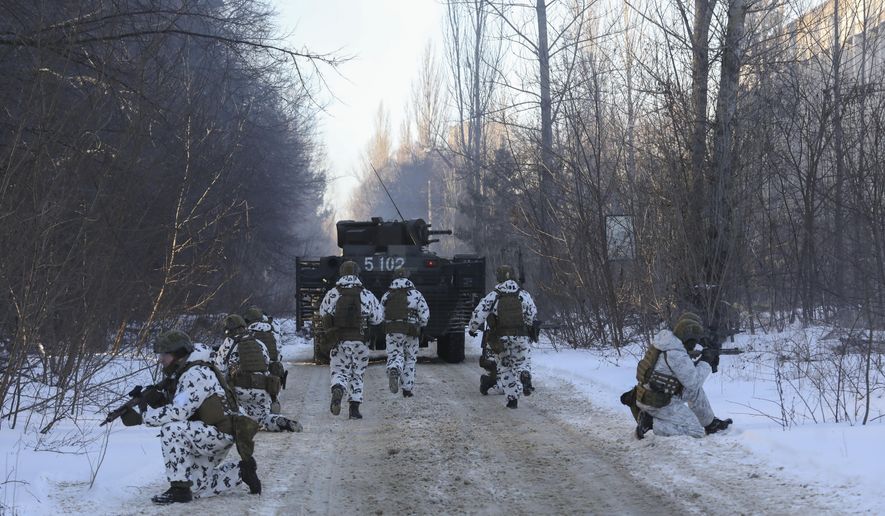Leaders in Kyiv began reaching out to U.S. military officials for help soon after Russia rolled into Ukraine following a tense buildup along the border that lasted several months. One of the first calls went out to the California National Guard.
For nearly 30 years after the demise of the Soviet Union, California’s soldiers have had a close working relationship with Ukraine as part of the National Guard State Partnership Program. Maj. Gen. David Baldwin, the state’s senior officer, known as the adjutant general, has been friends with top Ukrainian military leaders for a decade, officials said.
“When the invasion started, they started receiving phone calls: ‘Hey, we’re getting attacked,’ followed by phone calls shortly later that said, ‘Hey, here’s what we need,’” recalled Army Gen. Daniel Hokanson, the chief of the National Guard Bureau who also serves on the Joint Chiefs of Staff.
The State Partnership Program links former Warsaw Pact countries with U.S. states. Ukraine drew the California National Guard in the lottery. The relationship was intended to help forces operate more easily alongside NATO and provide guidance about the proper role of a military in a democracy.
“We initially worked on humanitarian assistance and disaster relief to help them to respond to their communities [and] to help them take care of their countries,” Gen. Hokanson said recently at a session hosted by the Foundation for Defense of Democracies in Washington.
Ukraine and the California Guard have had about 1,000 opportunities to work with each other over the past 27 years. “Over time, you continue to build on what you’ve learned,” Gen. Hokanson said.
The California Guard soldiers, many of them combat veterans with tours in Iraq and Afghanistan, trained the Ukrainians on various skills from the basics of small-unit tactics to larger joint operations. They also helped Ukraine develop a capable corps of noncommissioned officers — the sergeants in militaries who are crucial for accomplishing missions.
“That makes all the difference in the world,” Gen. Hokanson said.
Many military analysts and strategic thinkers predicted the larger and more powerful Russian army would easily defeat the Ukrainians in direct combat, a misconception apparently shared by Russian President Vladimir Putin and his military aides. The California Guard troops, who knew the improving quality of Ukrainian forces over the years, were more confident. For them, the Ukrainian army’s success at blunting Russia’s attack for nearly two months did not come as a shock.
“They said, ‘Hey, we’re not surprised they’re doing that well. We’ve trained with them, and we knew how good they were,’” Gen. Hokanson said. “You’re seeing that every single day right now.”
Gen. Baldwin, the California adjutant general, told DOD News last month that his long experience with Ukrainian forces led him to believe they were badly underestimated.
“We knew that they had radically improved their ability to do kind of Western-style military decision making,” he said. “I have been impressed, though, with their ability at the national level to work through some of the challenges we thought they still had in terms of logistics and command control.”
SEE ALSO: Ukraine marks Orthodox Easter with prayers for those trapped
Ukraine’s air force, Gen. Baldwin said, was a particular bright spot.
“Our fighter pilots have been telling everyone for years that the Ukrainian air force is pretty good …,” he said. “Well, the proof is in the pudding. Their air force is a lot better than everyone thought — except for the California Air National Guard, who knew that these guys were pretty good.”
Ukraine’s ability to mount a nimble, adroit form of maneuver warfare stands in stark contrast with the stolid, heavy-handed tactics of Russia, which relies on overwhelming artillery firepower to level cities and try to cow the opponent into submission.
“By working with [Ukraine] to establish leaders at the lowest level, really at the small-unit action level, they can seize the initiative, see an opportunity and take advantage of it,” Gen. Hokanson said. “We’re seeing that every day over there right now.”
The State Partnership Program was initially intended to guide the armies of satellite countries that had been under the thumb of the Soviet Union for decades. It has expanded dramatically, with 93 countries now linked to state National Guard contingents from all 50 states, three territories and the District of Columbia.
Ukraine’s success on the battlefield against Russia might persuade other countries to sign on with the State Partnership Program. The input from the combatant commanders — such as the heads of the U.S. Indo-Pacific Command, the Middle East-focused Central Command, or Southern Command for Latin America — will be crucial, Gen. Hokanson said.
“We’ll maintain a very close conversation with them on where they see potential opportunities for future state partners,” he said.
• Mike Glenn can be reached at mglenn@washingtontimes.com.




Please read our comment policy before commenting.